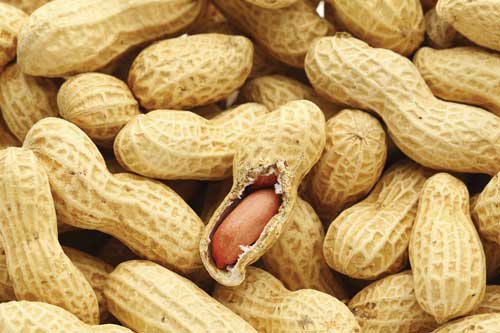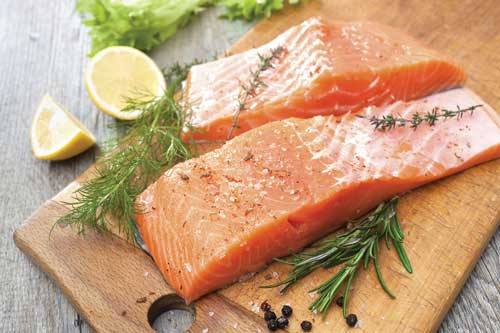Peanut Allergenicity; FDA approves GE fish; JFS anniversary issue
NEWS
 Germination decreases allergenicity of peanuts
Germination decreases allergenicity of peanuts
A recent study published online ahead of print in the Journal of Food Science examined the effects of germination under certain major environmental conditions on the allergenicity of peanut proteins and found that there is potential for controlling biological methods to reduce peanut allergenicity.
Allergenic proteins in peanuts are degraded during seed germination, and the authors surmised that by altering that natural process by controlling certain environmental factors, peanut allergenicity could be reduced. The study specifically looked at temperature and light effects on Ara h1, a previously identified peanut allergen. The results showed that the 40- and 65-kDa proteins in peanut seeds degraded rapidly, beginning at 60 hr (at 25°C) and 108 hr (at 20°C), and the corresponding immunoreactivity of Ara h1 decreased approximately one-third after 5–7 days of germination. More light and a higher temperature increased the seed germination rate, but both affected sprout quality; 25°C and dark surroundings were determined to be suitable for germination.
“Short-term germination could be an easy way to produce hypoallergenic peanut food,” the authors conclude, though they note that “further studies are needed to assess the effects of germination on other major peanut allergens and the clinical relevance of the study.”
JFS launches 75th anniversary virtual issue
Throughout IFT’s 75th anniversary year, Journal of Food Science editors recruited and published papers from top experts in their fields that best represented the spirit of this milestone. All 11 papers have been compiled in a special issue, “75 Years of Advancing Food Science, and Preparing for the Next 75.”
Topics include nanoscale nutrient delivery systems for food, crunchiness in puffed cereals and snacks, CRISPR-based technologies and the future of food science, and advances in mycotoxin research.
Click here to view the open-access issue.
Webcast discusses food fraud
Food fraud can take a variety of forms, ranging from mislabeling, tampering with contents, and reselling stolen items, according to a recent IFT live webcast sponsored by PerkinElmer. The speakers, Nicola Vosloo, food segment leader for PerkinElmer, and John Spink, director of Michigan State University’s Food Fraud Initiative, stressed the importance of prevention, encouraging companies to assess their vulnerabilities.
In addition, they discussed the use of mass spectrometry as a readily available rapid screening tool to test for food fraud, explaining that this method is good for both targeted and nontargeted testing—testers do not need to be looking for a specific substance to benefit from it. Spink closed the webcast by encouraging listeners to create a strategic approach to combating food fraud and take advantage of the technology they have at their disposal to do so.
Click here to view the webcast.
Preferred sweetness same after low-sugar diet
Individuals who completed a three-month low-sugar diet experienced no lasting change in their preferred levels of sweetness, although foods did taste sweeter to them, according to a recent study authored by researchers at the Monell Center that was published online ahead of print in the American Journal of Clinical Nutrition.
In the study, participants who typically consumed two or more soft drinks sweetened with either sugar or high fructose corn syrup each day were asked either to maintain their normal diet or to replace 40% of their calories from sugars with fats, proteins, and complex carbohydrates while maintaining their baseline caloric intake. After three months, both groups were asked to rate the sweet taste intensity and pleasantness of sweetened vanilla puddings and raspberry beverages. While the reduced-sugar group rated these as sweeter than did individuals who were not sugar-restricted, their stated preference for the level of sugar in these foods did not differ. In addition, after the three months, sugar-restricted participants quickly increased their sugar intake and perception of sweet taste intensity to prediet levels.
According to the Monell Center, these results differ from earlier studies focused on salt, which showed that people placed on a low-sodium diet came to prefer lower levels of salt in their food.
“The factors that underlie liking for sugar and salt may differ,” says study co-author Gary Beauchamp, a behavioral biologist at Monell. “The salt findings formed part of the rationale for the National Academy of Sciences’ recommendation to decrease salt consumption by gradually lowering the amount of salt in prepared and restaurant foods. Modern diets contain a large proportion of calories as sugar, but this same tactic may not work as well to help reduce the amount of sugar that people consume.”
--- PAGE BREAK ---
 FDA approves GE fish
FDA approves GE fish
The U.S. Food and Drug Administration (FDA) announced that it has approved AquAdvantage salmon, an Atlantic salmon genetically engineered (GE) by AquaBounty Technologies to reach market size more quickly than non-GE farm-raised Atlantic salmon. This approval is the first issued by the FDA for a genetically engineered animal intended for food.
“The FDA has thoroughly analyzed and evaluated the data and information submitted by AquaBounty Technologies regarding AquAdvantage salmon and determined that they have met the regulatory requirements for approval, including that food from the fish is safe to eat,” says Bernadette Dunham, director of the FDA’s Center for Veterinary Medicine.
According to William Muir, a genetics professor in Purdue University’s Dept. of Animal Sciences and an expert in animal genomics and well-being, biotechnology, and risk assessment of GE animals, the approval was based on data that showed no new allergens were created in the fish because no new proteins were expressed. He adds that the data also showed that the nutrient profile of the salmon was the same as the non-GE salmon.
The FDA also issued two guidances for manufacturers who wish to voluntarily label their products as containing ingredients from GE or non-GE sources. The first is a draft guidance on labeling foods derived from Atlantic salmon, and the second is a final guidance on foods derived from GE plants.
When it comes to whether consumers will accept salmon labeled this way, Muir believes that though consumers might question the salmon in the beginning, ultimately they will see its value. “There will be some initial concern,” he says, “but that concern will quickly go away when no adverse effects are reported—the proof is in the pudding.”
The FDA will accept comment on the draft guidance on labeling regarding Atlantic salmon for 60 days, beginning on Nov. 23. Click here to read the draft and here to comment.
News Bites
• AAK USA was awarded the Natural Products Assoc. 2015 Industry Champion Award, which recognizes notable contributions to the natural products industry above and beyond commercial success.
• Catherine Adams Hutt was quoted in a Vogue article about the benefits of microwave cooking.
• Archer Daniels Midland Co. and Matsutani opened a plant in Tianjin, China, to produce Fibersol soluble fiber.
• Barry Callebaut signed a licensing agreement with Naturex to market its approved health claim on Naturex’s cocoa extracts. It also acquired the commercial beverages vending activities of FrieslandCampina Kievit.
• Applications are open for the fifth Borlaug Summer Institute on Global Food Security, when 40 graduate students working to find solutions to world hunger will convene June 5–18 at Purdue University. The application deadline is Feb. 1; click here.
• ConAgra Foods will separate into two public companies. Conagra Brands will comprise its consumer brands and Lamb Weston its foodservice sector of frozen potato products.
• D.D. Williamson acquired the KleurCraft portfolio of coloring foods, custom formulations, and related technology from SVZ International B.V.
• DuPont Packaging is accepting applications for the DuPont Award for Packaging Innovation through Feb. 19, 2016. Click here to enter.
• Jack Fastag, a senior flavor chemist at David Michael & Co., contributed to “Flavor: Making It and Faking It,” the first exhibit by the Museum of Food and Drink in Brooklyn, N.Y. He will also host a Flavor Lab program there, which will educate attendees on flavor creation and usage and give them the chance to make their own flavors.
• GEA opened what it is calling the first manufacturing facility designed to withstand damages caused by earthquakes.
• Student member Dilara Konuk from the Izmir Institute of Technology in Turkey was recognized as a finalist for the Cargill-sponsored EFFoST Student of the Year Award.
• Ken Lee of The Ohio State University was named a 2015 Fellow by the American Assoc. for the Advancement of Science.
• Private label and contract manufacturer LiDestri Food and Beverage is expanding its manufacturing operations with the installation of a high pressure processing system.
• Lipogen is expanding its production facilities and building a new phospholipids research and development center.
• The Ohio State University student member David Phinney accepted a 2016 Seligman APV Fellowship, which enables recent food engineering graduates and postgraduates to spend six months working on project-based studies in the United Kingdom.
• Pinnacle Foods entered into a definitive agreement to acquire Boulder Brands.
• Jeffrey Strout, technical services independent trainer for Mérieux NutriSciences, was named 2015 SQFI Trainer of the Year by the Safe Quality Food Institute.
• The University of California Global Food Initiative celebrated its first anniversary and announced goals for its second year that include creating and sharing “toolkits” to prompt discussions about food at the campus, state, national, and international levels.
• Yael Vodovotz of The Ohio State University copresented “The Promise of Functional Foods: Translation from Crops to Community for Disease Prevention and Treatment” at Food and Nutrition Expo 2015.
 Melanie Zanoza Bartelme,
Melanie Zanoza Bartelme,
Associate Editor
[email protected]
